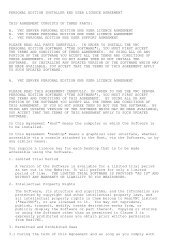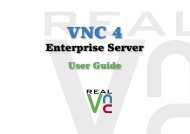VNC User Guide - RealVNC
VNC User Guide - RealVNC
VNC User Guide - RealVNC
You also want an ePaper? Increase the reach of your titles
YUMPU automatically turns print PDFs into web optimized ePapers that Google loves.
Chapter 6: Setting Up <strong>VNC</strong> Server<br />
Working with <strong>VNC</strong> Server in Virtual Mode<br />
Note: The information in this section applies to <strong>VNC</strong> Server for UNIX/Linux only.<br />
<strong>VNC</strong> Server in Virtual Mode starts unattached to any physical display hardware. This means that desktop<br />
artifacts to help you work with <strong>VNC</strong> Server, such as a <strong>VNC</strong> Server icon and <strong>VNC</strong> Server dialog, are not<br />
available.<br />
To configure <strong>VNC</strong> Server in Virtual Mode, you can instead:<br />
• Specify parameters on start-up. See Specifying parameters on start-up on page 77.<br />
• Configure <strong>VNC</strong> Server as a connected user. See Configuring <strong>VNC</strong> Server as a connected user on<br />
page 77.<br />
Note that changes made using either method are lost when <strong>VNC</strong> Server stops.<br />
Specifying parameters on start-up<br />
You can configure <strong>VNC</strong> Server in Virtual Mode on start-up using parameters.<br />
Parameters can be specified in configuration files, in which case they apply to all instances of <strong>VNC</strong> Server in<br />
Virtual Mode automatically, or at the command line when a particular instance starts. <strong>VNC</strong> Server reads<br />
parameters in the following order:<br />
1. The system configuration file: /etc/vnc/config.d/Xvnc.<br />
2. The configuration file of the user starting <strong>VNC</strong> Server: $HOME/.vnc/config.d/Xvnc.<br />
3. Appended to the vncserver-virtual command at the command line.<br />
Parameters specified later in this list override duplicates specified earlier.<br />
For a full list of parameters, run the command vncserver-virtual -list. For more information, run the<br />
command man vncserver-virtual.<br />
Configuring <strong>VNC</strong> Server as a connected user<br />
You can connect to <strong>VNC</strong> Server in Virtual Mode and configure it as a connected user. When you disconnect,<br />
your changes apply to all future connections to this instance of <strong>VNC</strong> Server while it runs.<br />
Note: To see how to use <strong>VNC</strong> Viewer to connect to <strong>VNC</strong> Server, read Connecting to a host computer on<br />
page 37. You will need to qualify the network address of the host computer with the X Server session<br />
number assigned when <strong>VNC</strong> Server starts, for example 192.168.0.187:1.<br />
Under most versions of UNIX/Linux, when you connect, a <strong>VNC</strong> Server icon is visible to the connected<br />
user. For more information on this icon, including how to use it to open the <strong>VNC</strong> Server dialog and configure<br />
<strong>VNC</strong> Server, start with Using the <strong>VNC</strong> Server icon on page 81.<br />
Note: If another user connects, the <strong>VNC</strong> Server icon is shaded black.<br />
<strong>VNC</strong> <strong>User</strong> <strong>Guide</strong> 77
















